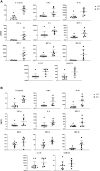Contribution of Puma to Inflammatory Resolution During Early Pneumococcal Pneumonia
- PMID: 35694536
- PMCID: PMC9177954
- DOI: 10.3389/fcimb.2022.886901
Contribution of Puma to Inflammatory Resolution During Early Pneumococcal Pneumonia
Abstract
Apoptosis of cells at the site of infection is a requirement for shutdown of inflammatory signaling, avoiding tissue damage, and preventing progression of sepsis. Puma+/+ and Puma-/- mice were challenged with TIGR4 strain pneumococcus and cytokines were quantitated from lungs and blood using a magnetic bead panel analysis. Puma-/- mice exhibited higher lung and blood cytokine levels of several major inflammatory cytokines, including IL-6, G-CSF, RANTES, IL-12, IFN-ϒ, and IP-10. Puma-/- mice were more susceptible to bacterial dissemination and exhibited more weight loss than their wild-type counterparts. RNA sequencing analysis of whole pulmonary tissue revealed Puma-dependent regulation of Nrxn2, Adam19, and Eln. Enrichment of gene ontology groups differentially expressed in Puma-/- tissues were strongly correlated to IFN-β and -ϒ signaling. Here, we demonstrate for the first time the role of Puma in prohibition of the cytokine storm during bacterial pneumonia. These findings further suggest a role for targeting immunomodulation of IFN signaling during pulmonary inflammation. Additionally, our findings suggest previously undemonstrated roles for genes encoding regulatory and binding proteins during the early phase of the innate immune response of pneumococcal pneumonia.
Keywords: PUMA (p53 upregulated modulator of apoptosis); apoptosis; inflammation; innate immunity; streptococcus pneumoniae (pneumococcus).
Copyright © 2022 Kennedy II, Mody, Gout, Tan, Seo, Olivier, Rosch and Thornton.
Conflict of interest statement
The authors declare that the research was conducted in the absence of any commercial or financial relationships that could be construed as a potential conflict of interest.
Figures




Similar articles
-
NLRP3 and ASC differentially affect the lung transcriptome during pneumococcal pneumonia.Am J Respir Cell Mol Biol. 2014 Apr;50(4):699-712. doi: 10.1165/rcmb.2013-0015OC. Am J Respir Cell Mol Biol. 2014. PMID: 24164497
-
Polyamine transporter in Streptococcus pneumoniae is essential for evading early innate immune responses in pneumococcal pneumonia.Sci Rep. 2016 Jun 1;6:26964. doi: 10.1038/srep26964. Sci Rep. 2016. PMID: 27247105 Free PMC article.
-
Protease activated receptor 4 limits bacterial growth and lung pathology during late stage Streptococcus pneumoniae induced pneumonia in mice.Thromb Haemost. 2013 Sep;110(3):582-92. doi: 10.1160/TH13-01-0052. Epub 2013 Jun 20. Thromb Haemost. 2013. PMID: 23783078
-
Trivalent pneumococcal protein recombinant vaccine protects against lethal Streptococcus pneumoniae pneumonia and correlates with phagocytosis by neutrophils during early pathogenesis.Vaccine. 2015 Feb 18;33(8):993-1000. doi: 10.1016/j.vaccine.2015.01.014. Epub 2015 Jan 15. Vaccine. 2015. PMID: 25597944
-
The p53-target gene puma drives neutrophil-mediated protection against lethal bacterial sepsis.PLoS Pathog. 2010 Dec 23;6(12):e1001240. doi: 10.1371/journal.ppat.1001240. PLoS Pathog. 2010. PMID: 21203486 Free PMC article.
Cited by
-
A novel growth-friendly system alleviates pulmonary dysplasia in early-onset scoliosis combined with thoracic insufficiency syndrome: Radiological, pathological, and transcriptomic assessments.Heliyon. 2024 Mar 13;10(6):e27887. doi: 10.1016/j.heliyon.2024.e27887. eCollection 2024 Mar 30. Heliyon. 2024. PMID: 38509966 Free PMC article.
References
-
- Bordon J., Aliberti S., Fernandez-Botran R., Uriarte S. M., Rane M. J., Duvvuri P., et al. . (2013). Understanding the Roles of Cytokines and Neutrophil Activity and Neutrophil Apoptosis in the Protective Versus Deleterious Inflammatory Response in Pneumonia. Int. J. Infect. Dis. 17 (2), e76–e83. doi: 10.1016/j.ijid.2012.06.006 - DOI - PubMed
Publication types
MeSH terms
Substances
LinkOut - more resources
Full Text Sources
Molecular Biology Databases
Research Materials
Miscellaneous

